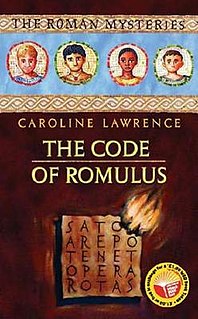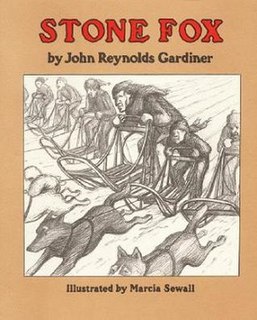 W
WThe Apple and the Arrow is a children's novella written and illustrated by Mary and Conrad Buff, published by Houghton Mifflin in 1951. It retells the legend of William Tell from the viewpoint of his 12-year-old son Walter. It is set in 1291, during the political upheaval that led to the foundation of the Old Swiss Confederacy.
 W
WThe Code of Romulus is a children's novella by Caroline Lawrence, published in 2007 to celebrate the 10th anniversary of World Book Day. It is a re-publication of the short story Bread and Circuses that appeared in the anthology The Mammoth Book of Roman Whodunits published in 2003.
 W
WCoraline is a dark fantasy children's novella by British author Neil Gaiman, published in 2002 by Bloomsbury and Harper Collins. It was awarded the 2003 Hugo Award for Best Novella, the 2003 Nebula Award for Best Novella, and the 2002 Bram Stoker Award for Best Work for Young Readers. The Guardian ranked Coraline #82 in its list of 100 Best Books of the 21st Century. Gaiman started writing Coraline in 1990. The titular character's name came from a typo in "Caroline". According to Gaiman, "I had typed the name Caroline, and it came out wrong. I looked at the word Coraline, and knew it was someone's name. I wanted to know what happened to her." It has been compared to Lewis Carroll's Alice's Adventures in Wonderland and has been adapted into a 2009 stop-motion film, directed by Henry Selick.
 W
WDoctor Aybolit is a fictional character from the children's poems Aybolit and Barmaley by Korney Chukovsky, as well as the children's fantastic novella Doctor Aybolit of the same author. The name may be translated as "Ouch, [it] hurts!"
 W
WThe Firework-Maker's Daughter is a children's novella by Philip Pullman. It was first published in the United Kingdom by Doubleday in 1995. The first UK edition was illustrated by Nick Harris; a subsequent edition published in the United States was illustrated by S. Saelig Gallagher.
 W
WThe Friendship is a children's novella by Mildred Taylor. Published in 1987, it is set in 1933 in Mississippi and deals with the unfair treatment of African Americans.
 W
WHaJaBaRaLa or HJBRL: A Nonsense Story is a children's novella by Sukumar Ray. Ha Ja Ba Ra La is considered one of the best nonsense stories of Bengali literature. To highlight its genre, artistic merit and style, it is frequently compared to Alice In Wonderland.
 W
WMagic Maize is a children's novella written and illustrated by Mary and Conrad Buff. Set in contemporary Guatemala, it describes the life and adventures of a boy from a traditional Mayan Indian family. First published in 1953, it was a Newbery Honor recipient in 1954.
 W
WThe Puppy Sister is a children's novella written by S. E. Hinton and published in 1995. The story revolves around Aleasha, a tricolor Australian Shepherd puppy who realises that the only way to really feel like a member of her new family is to become human. Aleasha begins a gradual, physical transformation from puppy to human child, trying to get used to both her new outward appearance as well as the struggle to actually feel more human. The story is based on her real life dog (Aleasha) and son's (Nick) relationship.
 W
WSeedfolks (1997) is a children's novella written by Paul Fleischman, with illustrations by Judy Pedersen. The story is told by a diverse cast of characters living on Gibb Street in Cleveland, Ohio, each from a different ethnic group. Chapter by chapter, each character describes the transformation of an empty lot into a vibrant community garden, and in doing so, they each experience their own transformations.
 W
WStone Fox is a children's novella by John Reynolds Gardiner. It is the first and best known of Gardiner's books. Stone Fox was acclaimed and very popular when it was published in 1980. It sold three million copies and was turned into a television movie starring Buddy Ebsen, Joey Cramer, and Gordon Tootoosis and directed by Harvey Hart in 1987. It was named a New York Times Notable Book of the Year for 1980, and was included in 100 Best Books for Children by Anita Silvey.
 W
WUncle Fedya, His Dog, and His Cat is a children's novella written by Eduard Uspensky and first published in 1974. It is the first story in the series set in the fictional village of Milkville created by Uspensky. The series features a city boy named Fyodor, or Fedya for short, and his friends, the talking animals. The stories focus on their adventures in Prostokvashino and their relationships with its residents, including the irritable postman Pechkin.